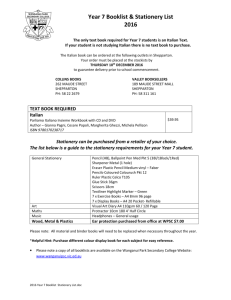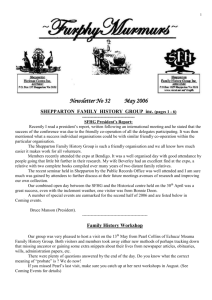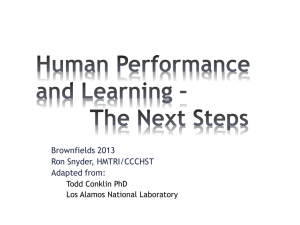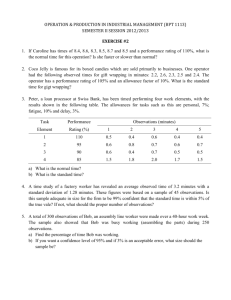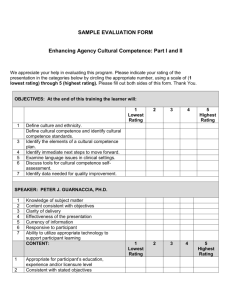Robert McLean (DOCX 22.99 KB)
advertisement
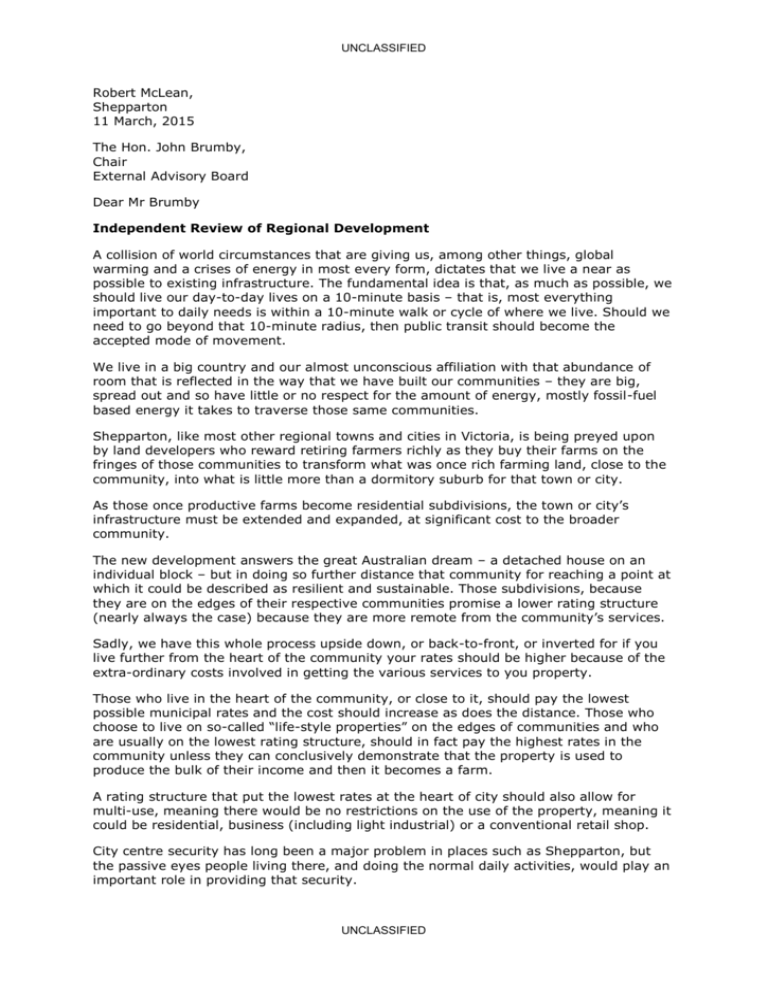
UNCLASSIFIED Robert McLean, Shepparton 11 March, 2015 The Hon. John Brumby, Chair External Advisory Board Dear Mr Brumby Independent Review of Regional Development A collision of world circumstances that are giving us, among other things, global warming and a crises of energy in most every form, dictates that we live a near as possible to existing infrastructure. The fundamental idea is that, as much as possible, we should live our day-to-day lives on a 10-minute basis – that is, most everything important to daily needs is within a 10-minute walk or cycle of where we live. Should we need to go beyond that 10-minute radius, then public transit should become the accepted mode of movement. We live in a big country and our almost unconscious affiliation with that abundance of room that is reflected in the way that we have built our communities – they are big, spread out and so have little or no respect for the amount of energy, mostly fossil-fuel based energy it takes to traverse those same communities. Shepparton, like most other regional towns and cities in Victoria, is being preyed upon by land developers who reward retiring farmers richly as they buy their farms on the fringes of those communities to transform what was once rich farming land, close to the community, into what is little more than a dormitory suburb for that town or city. As those once productive farms become residential subdivisions, the town or city’s infrastructure must be extended and expanded, at significant cost to the broader community. The new development answers the great Australian dream – a detached house on an individual block – but in doing so further distance that community for reaching a point at which it could be described as resilient and sustainable. Those subdivisions, because they are on the edges of their respective communities promise a lower rating structure (nearly always the case) because they are more remote from the community’s services. Sadly, we have this whole process upside down, or back-to-front, or inverted for if you live further from the heart of the community your rates should be higher because of the extra-ordinary costs involved in getting the various services to you property. Those who live in the heart of the community, or close to it, should pay the lowest possible municipal rates and the cost should increase as does the distance. Those who choose to live on so-called “life-style properties” on the edges of communities and who are usually on the lowest rating structure, should in fact pay the highest rates in the community unless they can conclusively demonstrate that the property is used to produce the bulk of their income and then it becomes a farm. A rating structure that put the lowest rates at the heart of city should also allow for multi-use, meaning there would be no restrictions on the use of the property, meaning it could be residential, business (including light industrial) or a conventional retail shop. City centre security has long been a major problem in places such as Shepparton, but the passive eyes people living there, and doing the normal daily activities, would play an important role in providing that security. UNCLASSIFIED UNCLASSIFIED Rather than expand on the edges of our communities, we should be looking inward and searching for infill sites within those same communities that through the cooperation, and endorsement, of the Local Government body (in this case the City of Greater Shepparton) could be consolidated under the one title to make it attractive to developers. Beyond that, and probably the biggest challenge of all, is to change the mindset of most Australians who see a densification of living as a step toward the creation of slums – that is in fact not true modern community developments all around the world clearly demonstrate. Whether we agree or not, we are by nature social creatures (that’s a wonderful human value that has played vital and critical role in shaping our communities) and in a world constrained by energy we should be working towards building communities that in some way reflect the “hive” or the “ants’ nest” for they are wonderful examples of home many organisms live close to one another, support each other and frequently make life possible in quite hostile environments. My earlier foray into being on city council appointed community committee to consider the rating structure brought little joy. In fact the idea that using the rating structure to subtly drag people back to the heart of their communities seemed to be something beyond the understanding and imagination of all on the committee and it was thought that had never crossed their mind. There is no doubt in my mind that Shepparton, for instance, is a car-bound community that will collapse into disarray as fuel prices sky-rocket (as the most certainly will) and we have failed to create a densification that makes it possible for most of us to complete out day-to-day lives either by walking or cycling; or using sophisticated public transit system, including between Goulburn Valley towns. I would appreciate to opportunity to meet with you and provide further detail on the above. Yours sincerely, Robert McLean, Shepparton. UNCLASSIFIED
